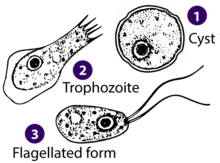നെഗ്ലേരിയ ഫൗലേരി
പ്രൈമറി അമീബിക് മെനിംഗോഎൻസെഫലൈറ്റിസ് (PAM) എന്ന അപൂർവവും കഠിനവുമായ മസ്തിഷ്ക അണുബാധയ്ക്ക് കാരണമാകുന്ന ഒരു ഏകകോശ അമീബയാണ് നെഗ്ലേരിയ ഫൗളറി. തടാകങ്ങൾ, ചൂടുനീരുറവകൾ, മോശമായി പരിപാലിക്കപ്പെടുന്ന നീന്തൽക്കുളങ്ങൾ തുടങ്ങിയ ചൂടുള്ള ശുദ്ധജല പരിതസ്ഥിതികളിലാണ് ഇത് സാധാരണയായി കാണപ്പെടുന്നത്.[1]
| നെഗ്ലേരിയ ഫൗലേരി | |
|---|---|

| |
| നേഗ്ലേരിയ ഫൗലേരിയുടെ ജീവിതചക്രത്തിന്റെ ഘട്ടങ്ങളും ആ ഘട്ടത്തിലെ പരിസ്ഥിതിയും ചിത്രീകരിക്കുന്ന ഡയഗ്രം. | |

| |
| 'നെഗ്ലേരിയ ഫൗലേരി'യുടെ ജീവിതചക്രത്തിന്റെ മൂന്ന് ഘട്ടങ്ങളുടെ ഡ്രോയിംഗുകൾ. | |
| ശാസ്ത്രീയ വർഗ്ഗീകരണം | |
| Missing taxonomy template (fix): | Naegleria |
| Species: | Template:Taxonomy/NaegleriaN. fowleri
|
| Binomial name | |
| Template:Taxonomy/NaegleriaNaegleria fowleri Carter (1970)
| |
സാധാരണയായി നീന്തൽ അല്ലെങ്കിൽ ഡൈവിംഗ് പോലെയുള്ള പ്രവർത്തനങ്ങളിൽ മലിനമായ വെള്ളം മൂക്കിലൂടെ ശരീരത്തിൽ പ്രവേശിക്കുമ്പോൾ നെയ്ഗ്ലേരിയ ഫൗളറി ഘ്രാണ നാഡിയിലൂടെ തലച്ചോറിലേക്ക് സഞ്ചരിക്കുന്നു. തുടർന്ന് മസ്തിഷ്ക കോശങ്ങളുടെ വീക്കം, നാശം എന്നിവയ്ക്ക് കാരണമാകുന്നു.[2]
നേഗ്ലേരിയ ഫൗലേരി അണുബാധയുടെ ലക്ഷണങ്ങൾ സാധാരണയായി സമ്പർക്കം കഴിഞ്ഞ് ഒന്നു മുതൽ ഒമ്പത് ദിവസത്തിനുള്ളിൽ പ്രത്യക്ഷപ്പെടും. കഠിനമായ തലവേദന, ഉയർന്ന പനി, കഴുത്ത് കാഠിന്യം, ഓക്കാനം, ഛർദ്ദി, മലബന്ധം എന്നിവ ഉൾപ്പെടാം. അണുബാധ അതിവേഗം പടരുകയും സാധാരണഗതിയിൽ മാരകമാവുകയും ചെയ്യും.[3] അതിജീവിക്കാനുള്ള സാധ്യത വളരെ കുറവായി കാണുന്നു.
നേഗ്ലേരിയ ഫൗളറി അണുബാധ വളരെ അപൂർവമാണ്. അമീബയെ വിഴുങ്ങുകയോ ചർമ്മവുമായി സമ്പർക്കം പുലർത്തുകയോ ചെയ്താൽ അസുഖം വരില്ല.[4] ചൂടുള്ള ശുദ്ധജല സ്രോതസ്സുകൾ ഒഴിവാക്കുക, ജല പ്രവർത്തനങ്ങളിൽ പങ്കെടുക്കുമ്പോൾ നോസ് ക്ലിപ്പുകൾ പോലുള്ള മുൻകരുതലുകൾ എടുക്കുക എന്നിവ അണുബാധയ്ക്കുള്ള സാധ്യത കുറയ്ക്കും.[5]
അവലംബം
തിരുത്തുക- ↑ Schuster, Frederick L.; Visvesvara, Govinda S. (2004). "Free-living amoebae as opportunistic and non-opportunistic pathogens of humans and animals". International Journal for Parasitology. 34 (9): 1001–1027. doi:10.1016/j.ijpara.2004.06.004. PMID 15313128.
- ↑ "Texas residents warned of tap water tainted with brain-eating microbe". The Guardian. Associated Press. 26 September 2020. Archived from the original on 27 September 2020. Retrieved 27 September 2020.
- ↑ Sykora, J. L.; Keleti, G.; Martinez, A. J. (1983). "Occurrence and pathogenicity of Naegleria fowleri in artificially heated waters". Appl Environ Microbiol. 45 (3): 974–9. Bibcode:1983ApEnM..45..974S. doi:10.1128/AEM.45.3.974-979.1983. PMC 242399. PMID 6847189.
- ↑ Maclean, RebeccaC.; Richardson, DennisJ.; LePardo, Robin; Marciano-Cabral, Francine (2004). "The identification of Naegleria fowleri from water and soil samples by nested PCR". Parasitology Research. 93 (3): 211–217. doi:10.1007/s00436-004-1104-x. PMID 15138806. S2CID 5972631.
- ↑ Sheehan, Kathy B.; Fagg, Jennifer A.; Ferris, Michael J.; Henson, Joan M. (2003). "PCR Detection and Analysis of the Free-Living Amoeba Naegleria in Hot Springs in Yellowstone and Grand Teton National Parks". Applied and Environmental Microbiology. 69 (10): 5914–5918. Bibcode:2003ApEnM..69.5914S. doi:10.1128/AEM.69.10.5914-5918.2003. PMC 201221. PMID 14532044.